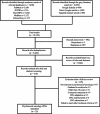Finding a needle in a haystack: The identification of clinical practice guidelines for psychosocial oncology through an environmental scan of the academic and gray literature
- PMID: 38400664
- PMCID: PMC10891449
- DOI: 10.1002/cam4.7039
Finding a needle in a haystack: The identification of clinical practice guidelines for psychosocial oncology through an environmental scan of the academic and gray literature
Abstract
Objective: Clinical practice guidelines (CPGs) are evidence-based tools well-suited to translate the latest research evidence into recommendations for routine clinical care. Given the rapid expansion of psychosocial oncology research, they represent a key opportunity for informing the treatment decisions of overburdened clinicians, standardizing service delivery, and improving patient-reported outcomes. Yet, there is little consensus on how clinicians can most effectively access these tools and little to no information on the current availability and scope of CPGs for the range of psychosocial symptoms and concerns experienced by patients with cancer.
Method: Our environmental scan consisted of an academic and gray literature designed to identify currently available CPGs addressing a range of cancer-related psychosocial symptoms.
Results: Findings revealed a total of 23 existing psychosocial oncology CPGs that met full eligibility criteria. The gray literature search was found to be more effective at identifying CPGs (n = 22) compared to the academic search (n = 9).
Conclusion: Several concerns arose from the systematic search. The limited publication of CPGs in peer-reviewed journals may make clinicians and stakeholders more hesitant to implement CPGs due to uncertainties about the methodological rigor of the development process. Further, many existing CPGs are outdated or failed to be updated according to guideline recommendations, meaning that the recommendations may fall short of their purpose to translate up-to-date research findings.
Future directions: Future research should seek to systematically assess the quality of existing psychosocial oncology CPGs and shed light on the current state of implementation and adherence in clinical practice in order to better inform guideline developers on the current needs of the psychosocial oncology community.
Keywords: clinical practice guidelines; evidence-based practice; psychosocial oncology; supportive care for cancer.
© 2024 The Authors. Cancer Medicine published by John Wiley & Sons Ltd.
Conflict of interest statement
The authors declare they have no conflict of interests.
Figures
References
-
- Sung H, Ferlay J, Siegel RL, et al. Global cancer statistics 2020: GLOBOCAN estimates of incidence and mortality worldwide for 36 cancers in 185 countries. CA Cancer J Clin. 2021;71(3):209‐249. - PubMed
-
- World Health Organization . Cancer. 2020. https://www.who.int/health‐topics/cancer#tab=tab_1
-
- Dekker J, Braamse A, Schuurhuizen C, et al. Distress in patients with cancer–on the need to distinguish between adaptive and maladaptive emotional responses. Acta Oncol. 2017;56(7):1026‐1029. - PubMed
-
- Lam WW, Shing YT, Bonanno GA, Mancini AD, Fielding R. Distress trajectories at the first year diagnosis of breast cancer in relation to 6 years survivorship. Psychooncology. 2012;21(1):90‐99. - PubMed
Publication types
MeSH terms
Grants and funding
LinkOut - more resources
Full Text Sources
Medical
Miscellaneous


